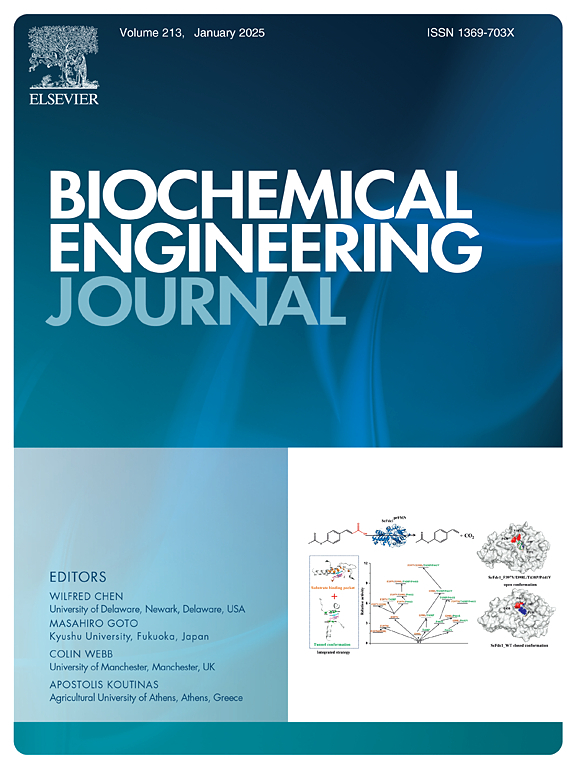Unraveling the residual sludge-mediated waste transformation and physiological regulation mechanism of Tetradesmus obliquus
IF 3.7
3区 生物学
Q2 BIOTECHNOLOGY & APPLIED MICROBIOLOGY
引用次数: 0
Abstract
The accumulation of residual sludge as process waste from water treatment engineering needs to be addressed urgently. Tetradesmus obliquus is an important algal species in the field of wastewater treatment. In this study, T. obliquus was cultured in different sludge extract to determine its ability to utilize wastes from the liquid phase and convert them into biomass, and to analyze the response of the microalgae to toxic stress using proteomics. The results showed that the sludge extract medium was superior to the BG11 medium in accumulating biomass, with dry weights, proteins and polysaccharides at least 1.09, 1.12 and 1.28 times higher than those of BG11 medium. In toxic group, T. obliquus reduced TOC from an initial 426.8±20.0 mg/L to 180.4±8.5 mg/L with a simultaneous 48.4 % reduction in toxicity. Toxic sludge extract produced greater damage to the photosystem of T. obliquus compared to the blank, significantly inhibiting the expression of two photosystem II core proteins, A0A383VSL5 (0.290 down) and A0A383V2Z3 (0.308 down), on day 5. However, these impairments were reversible, and at day 20, the expression of A0A383VSL5 was not inhibited, the inhibitory effect of A0A383V2Z3 (0.575 down) was attenuated. These results fill a gap on the treatment of various types of residual sludge by T. obliquus and provide promising strategies for microalgae treatment of residual sludge, whether non-toxic or toxic.
揭示剩余污泥介导的废物转化和斜管四孢蘑菇的生理调节机制
作为水处理工程中的工艺废物,剩余污泥的积累问题亟待解决。四裂殖藻(Tetradesmus obliquus)是废水处理领域的一种重要藻类。本研究用不同的污泥萃取物培养四裂殖藻,以确定其利用液相废物并将其转化为生物量的能力,并利用蛋白质组学分析微藻对毒性胁迫的响应。结果表明,污泥提取物培养基在积累生物量方面优于 BG11 培养基,其干重、蛋白质和多糖含量至少是 BG11 培养基的 1.09、1.12 和 1.28 倍。在有毒组中,T. obliquus 可将 TOC 从最初的 426.8±20.0 mg/L 降至 180.4±8.5 mg/L,同时毒性降低 48.4%。与空白提取物相比,有毒污泥提取物对斜管蛙的光系统造成了更大的破坏,在第 5 天显著抑制了两种光系统 II 核心蛋白 A0A383VSL5(0.290 下降)和 A0A383V2Z3(0.308 下降)的表达。然而,这些损伤是可逆的,在第 20 天,A0A383VSL5 的表达没有受到抑制,A0A383V2Z3(0.575 下调)的抑制作用有所减弱。这些结果填补了奥氏藻类处理各类剩余污泥的空白,为无毒或有毒的微藻处理剩余污泥提供了前景广阔的策略。
本文章由计算机程序翻译,如有差异,请以英文原文为准。
求助全文
约1分钟内获得全文
求助全文
来源期刊

Biochemical Engineering Journal
工程技术-工程:化工
CiteScore
7.10
自引率
5.10%
发文量
380
审稿时长
34 days
期刊介绍:
The Biochemical Engineering Journal aims to promote progress in the crucial chemical engineering aspects of the development of biological processes associated with everything from raw materials preparation to product recovery relevant to industries as diverse as medical/healthcare, industrial biotechnology, and environmental biotechnology.
The Journal welcomes full length original research papers, short communications, and review papers* in the following research fields:
Biocatalysis (enzyme or microbial) and biotransformations, including immobilized biocatalyst preparation and kinetics
Biosensors and Biodevices including biofabrication and novel fuel cell development
Bioseparations including scale-up and protein refolding/renaturation
Environmental Bioengineering including bioconversion, bioremediation, and microbial fuel cells
Bioreactor Systems including characterization, optimization and scale-up
Bioresources and Biorefinery Engineering including biomass conversion, biofuels, bioenergy, and optimization
Industrial Biotechnology including specialty chemicals, platform chemicals and neutraceuticals
Biomaterials and Tissue Engineering including bioartificial organs, cell encapsulation, and controlled release
Cell Culture Engineering (plant, animal or insect cells) including viral vectors, monoclonal antibodies, recombinant proteins, vaccines, and secondary metabolites
Cell Therapies and Stem Cells including pluripotent, mesenchymal and hematopoietic stem cells; immunotherapies; tissue-specific differentiation; and cryopreservation
Metabolic Engineering, Systems and Synthetic Biology including OMICS, bioinformatics, in silico biology, and metabolic flux analysis
Protein Engineering including enzyme engineering and directed evolution.
 求助内容:
求助内容: 应助结果提醒方式:
应助结果提醒方式:


